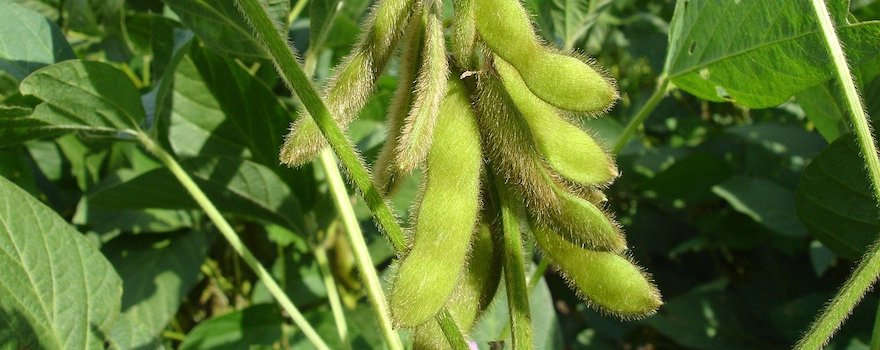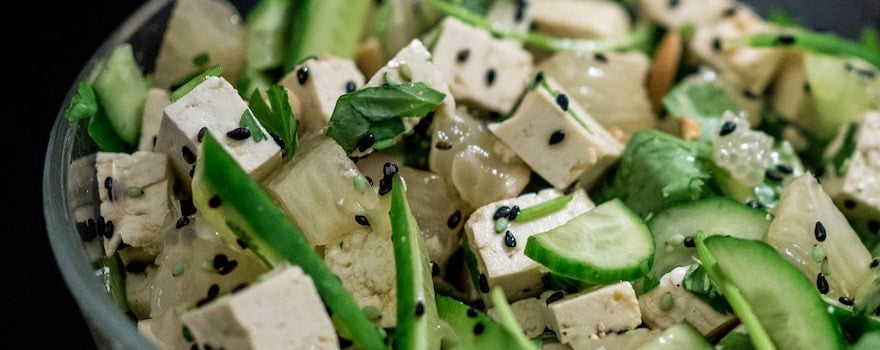BENEFITS OF SOY
✓ Source of plant-based proteins
✓ Reduces cholesterol
✓ Supports bone health
✓ Improves menopause symptoms
✓ Protects the heart
What is soy?
Like lupin, lentils, or fenugreek, soy (Glycine max) is a legume from the Fabaceae family. It can grow up to 1.30 m in height and produces hairy pods that contain up to 4 seeds. These seeds are harvested, consumed as is, or processed.
Originally from Asia, it was first cultivated in China 3,000 to 5,000 years ago. Gradually, the plant was introduced to Japan, Europe, and then the United States, which is today the world’s largest producer.
Soy consumption saw a real resurgence in the 90s. Presented as a healthy and nutritious food, it appeals to individuals concerned about their health who wish to reduce or eliminate their meat consumption.
It is one of the most well-known alternatives to replace meat in a vegetarian or vegan diet. Indeed, it has a high content of plant-based proteins and contains all essential amino acids. Soy seeds also contain fibers, fatty acids, vitamins, minerals, and trace elements.
Widely studied, it offers numerous health benefits. In addition to being an excellent protein source, it reduces cholesterol, supports bone health, and improves menopause symptoms. It is also recognized for its cardioprotective effect.
Soy is now ranked 7th among the world’s leading agricultural productions. About 70% of production is intended for animal feed and processed into soy meal. In recent years, it has experienced phenomenal growth, especially in South America. Unfortunately, this development has a heavy environmental impact: alongside palm oil, soy contributes greatly to deforestation, hence the importance of properly managing its source.
Nutritional Composition
- 18 amino acids
- Vitamins: pro-vitamin A, B1, B2, B3, B5, B6, B8, B9, E, K
- Minerals and trace elements: calcium, chlorine, copper, iron, magnesium, manganese, phosphorus, potassium, sodium, zinc
- Lipids
- Proteins
- Carbohydrates
- Fibers
- Fatty acids: omega 3-6-9
- Antioxidant actives: isoflavones

The Benefits of Soy
🌿 Source of plant-based proteins
With 38 g per 100 g, soy is among the best sources of plant-based proteins. It is therefore a very interesting food to reduce or even eliminate animal proteins from your diet.
The proteins it contains also have the advantage of being complete, meaning they contain all the essential amino acids for the human body. You will find valine, phenylalanine, leucine, and the valuable tryptophan among them.
This review by Loyola University Chicago Stritch School of Medicine (United States) studied the composition of soy and its protein content.
Also read Our tips for buying plant-based proteins
🍳 Reduces cholesterol
Soy helps lower blood cholesterol levels. It notably reduces LDL cholesterol levels (or “bad cholesterol”) which deposits on the vessel walls and leads to artery blockage.
This action is largely due to the isoflavones it contains. Besides fighting free radicals, these molecules decrease blood lipid levels, including cholesterol and triglycerides.
This study from Japan’s National Institute of Health and Nutrition, conducted in humans, shows the benefits of soy on cholesterol levels.
🦴 Supports bone health
Soy isoflavones also have a beneficial effect on bone health. They improve bone mineral density (BMD) and bone renewal for strong and resistant bones. This legume is particularly studied as a potential agent in the prevention and treatment of osteoporosis, a skeletal disease linked to aging.
This study from the National Institute of Health and Nutrition in Tokyo (Japan), conducted in postmenopausal women, shows how soy can prevent osteoporosis and improve bone strength.
🌺 Improves Menopausal Symptoms
Soy isoflavones are not only antioxidants. They are also natural phytoestrogens and have effects similar to female hormones (estrogens).
This legume contains three major isoflavones called genistein, daidzein, and glycitein. These increase the estrogen levels that drop during menopause and reduce symptoms associated with hormonal changes such as hot flashes.
This study from the University of Ferrara (Italy), conducted in postmenopausal women, shows how soy reduces the frequency of hot flashes.
❤️ Protects the Heart
Soy has a beneficial effect on the heart. On one hand, it limits cardiovascular risk factors such as hypercholesterolemia, atherosclerosis, or high blood pressure. On the other hand, it supports heart mechanisms and improves vasodilation.
The fibers and fatty acids it contains also contribute to cardiovascular health and disease prevention.
This review from the Guelph Research and Development Center (Canada) highlights the mechanisms of soy’s action to prevent cardiovascular diseases.

Is Soy a Health Risk?
For many years, soy has been the subject of controversy due to its phytoestrogen content. These are accused of causing hormonal imbalances in non-menopausal women. Additionally, because it reduces iodine absorption, it can cause thyroid dysfunction.
But these negative effects occur only in cases of excessive consumption. If you want to replace meat in your meals, eat it in reasonable amounts and vary your plant protein sources: cereals, legumes…
How to Consume Soy?
Soy-based Preparations
Soy-based products are numerous. They come in the form of milk, flour, sprouted seeds, soy sauce, soy proteins, or even vegetable oil. It can also be consumed in the form of:
- tofu, a white paste obtained from the curdling of soy milk. It can be firm (sold in patty or cube form) or silken (with a softer, grainier texture).
- tempeh, a culinary specialty made from cooked, crushed, and fermented soybeans.
- miso, a traditional Japanese food made from fermented soy paste.
Vegetarians and flexitarians will enjoy soy steaks, tofu vegetable sausages, or soy protein nuggets. So many original and tasty meat alternatives.

Soy Flour
Little known, soy flour nevertheless has taste and nutritional qualities. Once harvested, soybeans are ground into a powder to obtain a fine light yellow flour. Like rice, buckwheat, or quinoa flour, soy flour is naturally gluten-free. It is therefore interesting for people intolerant, allergic, or sensitive to gluten.
Soy flour has a slightly bitter taste. If you don’t like it, opt for roasted soy flour with a nutty flavor, milder and sweeter. This flour is used for preparing bread, pasta, cakes, vegetarian patties… It also helps thicken and bind sauces, replace butter, and eggs.
Soy Lecithin
Soy lecithin is an emulsifying or stabilizing agent present as an additive in many processed foods. It is a by-product of soy oil, containing choline, which is beneficial for the heart and liver and has good anti-cholesterol properties.
It is also found in dietary supplements. In this case, it is important to be cautious about its origin as it can be GMO-derived.
Consume sustainably: prioritize organic, local, and fair-trade soy
✓ Global soy production is shared between the United States, Brazil, and Argentina. As for France, it has about 155,000 hectares of soy and its cultivation continues to progress. It is mainly grown in the southwest and east of France, but also in Brittany, as here in Finistère.
✓ If you can, favor non-GMO soy, grown in France, and organic farming. Also, choose fair-trade products to support the work of small farmers.

Dosage
It is recommended to consume about 30 g of soy per day.
Contra-indications and side effects
The consumption of soy presents some contraindications :
- As a precaution, it is not recommended for pregnant and breastfeeding women and young children ;
- People suffering from hyperthyroidism should avoid consuming it ;
- Due to its isoflavone content, consumption is not recommended for those with personal or family histories of hormone-dependent cancers.
Excessive consumption presents certain side effects :
- Gastrointestinal disorders
- Nausea
- Allergic reaction
If you experience side effects, discontinue consumption and consult a doctor.
File created by Julia Perez
Sources and scientific studies
Gyoung-Ah Lee, Gary W. Crawford, Li Liu, Yuka Sasaki, Xuexiang Chen. 2011 Archaeological Soybean (Glycine max) in East Asia: Does Size Matter ?
Aaron J Michelfelder, 2009. Soy: a complete source of protein.
Kyoko Taku, Keizo Umegaki, Yoko Sato, Yuko Taki, Kaori Endoh, Shaw Watanabe, 2007. Soy isoflavones lower serum total and LDL cholesterol in humans: a meta-analysis of 11 randomized controlled trials.
Kyoko Taku, Melissa K Melby, Nobuo Nishi, Toyonori Omori, Mindy S Kurzer, 2011. Soy isoflavones for osteoporosis: an evidence-based approach.
P Albertazzi, F Pansini, G Bonaccorsi, L Zanotti, E Forini, D De Aloysio, 1998. The effect of dietary soy supplementation on hot flushes.



